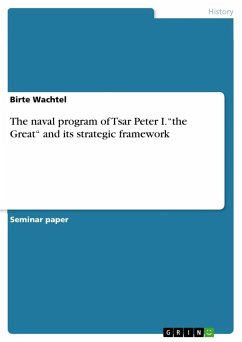Seminar paper from the year 2007 in the subject History of Europe - Middle Ages, Early Modern Age, grade: 2,0, Helmut Schmidt University - University of the Federal Armed Forces Hamburg, language: English, abstract: The British Telegraph published the article entitled "Navy to cut its fleet by half" on its cover on the 5th January 2007. The article stated that "what was once world's most formidable fleet", has to be reduced by half. The reason given for those major cuts is as often money. In the 17th century British sailors along with other European sailors formed the backbone of Tsar Peter the First's fleet. Even then a fleet cost a huge amount of money, not just building it but maintaining it in shape or even going to war. Peter was very willing to spend that money because his opinion was that "every potentate leader of an army has one arm but the one who has a fleet also has two arms". Although times have changed since then the British are still concerned about the sizes of the fleets of other European nations: "the French Navy, which will be far superior to the Royal Navy after the cuts". A senior officer was also quoted saying: "What this means is that we are now no better than a coastal defence force or a fleet of dug-out canoes. The Dutch now have a better navy than us."As shown, even today having a big fleet is connected with pride, power, and potential that no one wants to be lacking. To further understand Peter's ambitions I started this work with a short overview of his family background and adolescence.This paper deals with the impact on the productive, social, and behavioural levels that Tsar Peter I. had on Russia when he was building the navy. I will not deal with the beginning of the industrialisation but will touch the economic sector when it comes to shipbuilding for example.The Tsar tried to change the Russian's attitude towards a European one, wanting a modern western Russian culture. Therefore he took over western administration standards, removed old traditions and habits and decreased the power of the church. European laws and economic-political related acts became Russian laws just out of fashion although the conditions were not necessarily equal. The most famous and radical change in appearance was the cutting of the traditional beards. He also fashioned German clothes and hairstyles including wigs. Along with that came the habit of smoking tobacco and new destinations for holidays and new ways of spending them...
Hinweis: Dieser Artikel kann nur an eine deutsche Lieferadresse ausgeliefert werden.
Hinweis: Dieser Artikel kann nur an eine deutsche Lieferadresse ausgeliefert werden.








